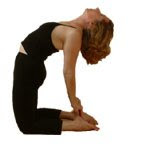
I found through my personal and teaching experience that this flow can help energize you and open the body laterally. My students have often commented that they would like “to do this in class more regularly”. Warrior II strengthens and tones the leg and abdominal muscles. It also creates flexibility in the leg and back muscles, and develops poise, confidence and endurance. Triangle Pose strengthens the legs, feet, ankles, knees and chest. It opens tight hips and stretches the lateral muscles along the spine and side body.
You can repeat the flow 2-5 repetitions. Let’s break down the steps for this wonderful flow:
Begin in Samasthiti.
Now, inhale, bend your knees, and jump or step your right foot back 4 to 4 1/2 feet (about one leg's length distance apart). Your right foot points directly to the back of your mat and the left foot turns in 45-degrees. Bring both arms shoulder high parallel to the floor with your palms facing down. You can flip your palms to the ceiling to get your shoulders to go back and down. Then keep your shoulders back and down as you turn your palms back to the floor.

Exhale lower your right knee down over your ankle. Right knee is over the right ankle at a 90-degree angle with strength in the back leg. Look over your right fingertips. Your spine is straight from tailbone to top of head. Hold for 1-5 breaths. ** Note ** to practice the correct alignment of Warrior Pose II, we focus on a straight spine from tailbone to top of head. To practice this correctly open your hips to the long edge of your practice mat. If there are neglected muscles in the hips that are holding you back from a straight spine, release the depth of the lunge and work with opening the hips first. Remember that alignment is more important the depth. As we learn how to hold our hips correctly, we can then practice moving into full pose.

Inhale push straight up by straightening your bent leg.

Exhale through the hips reaching the right hand out and then down to your foot or shin. Your left hip comes slightly around. Extend the left arm up to the sky. Your shoulders roll back, keep your neck long, tuck in your chin, and there is a slight rotation of your left ribs towards the sky. You should feel the lateral muscles supporting and lengthening your spine, tailbone to top of head. We are trying to create a straight spine and take it parallel to the floor. Avoid arching your spine. For this to happen there has to be a movement through the hips, where the left hip pushes to the back of the mat and rotates slightly forward to the long edge of the mat. There is a deep crease forming at the right hip and a straight spine extends out of this foundation. If you were against a wall, your shoulders and tailbone would be touching the wall. Hold for 1-5 breaths.
Inhale come up slowly with straight arms and straight spine. Switch your feet.
Exhale; go right down to the other side in Warrior II pose by bending your left knee. Look over your left fingertips. Your left knee is over the left ankle with a straight spine. The back leg is strong and straight. Hold for 1-5 breaths.
Inhale push straight up by straightening your bent leg.
Exhale; move into the Triangle pose on the left side. Remember, it's a shift through the hips that takes you into pose and not an arching of the spine. Extend your right arm up to the sky. Your shoulders roll back, keep your neck long, tuck in your chin, and slightly rotate your torso. You should feel the lateral muscles along your spine lengthening. Hold for 1-5 breaths.
Inhale; as you come up slowly arms outstretched by pushing straight up and straighten your bent leg.
Exhale back foot to front foot. Samasthiti. Now repeat the flow as desired.




